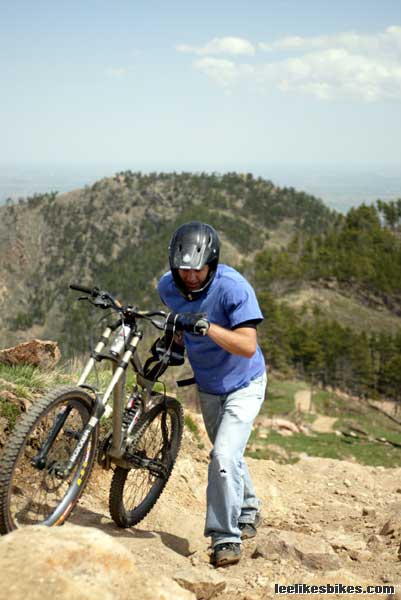Full face helmet for trail riding?
To cover your face or not: This question raises questions of safety, comfort and politics.
Lee,
Last weekend, I was riding with a group when one us stacked in some style from a smallish drop off (less than 30 inches). The unlucky individual had a nasty faceplant which cost him a fractured jaw, broken nose and 3 teeth.
It’s not clear whether or not he actually tried to ride the drop or just missed the checkin run. Anyway, although none of us would pidgeon hole ourselves as freeriders, downhillers or XC riders (I reckon we are archetypal trail riders). We’re all wondering about the benefits of full face lids.
Apart from the MET Parachute (which is too narrow for me to get my ears into!), are there any other full face lids that are remotely suitable for the kind of trail riding I think most of do (i.e., pedal all the way up and let rip on the way back down)? I think Giro used to make something called a Switchblade that might have fitted the bill, but everything else looks like it’ll cook my head on the way up.
Thanks,
Don
Hey Don,
Youch! You raise a great question. Let’s get into this:
 Elliott Hoover earns elevation at Left Hand Canyon OHV Area, where the other trail users have guns, and they are not afraid of mountain bikers. |
Safety
No question: Full face helmets provide more protection than half shells. No matter who you are or how you ride, when your face hits the ground you really want that face guard.
Comfort
High-end full face helmets are pretty light and pretty cool, but they pretty much suck for extended climbing. That’s why almost every pedal-driven rider wears an open face.
If you’re climbing, you don’t want your face covered. If you’re pinning downhills, you should have your face covered. This isn’t a place to compromise. That’s probably why Giro discontinued the Switchblade.
Politics
I don’t care how courteous and controlled you are; wearing a full face helmet on a public trail scares the civilians. Equestrians, hikers, even XC riders — they all assume you’re a dangerous daredevil.
A couple years ago I was riding a semi-remote trail on the DH bike, and I was wearing a full face and goggles. I was hauling mail through a rocky section, and I spotted a Lycra rider coming up the hill. No big deal: I carried speed through the rocks, found a piece of good dirt and shut that thing down. Dude, I had 2.5″ sticky tires, 8-inch rotors, 8 inches of suspension and perfect braking technique. There was no skidding. There was no violence. I stopped on the side of the trail with plenty of margin and said an enthusiastic Hello.
Too late. The guy’s eyes were bugging out, and he was beyond panic. The vision of the faceless, high-speed demon was too much for the guy. Never mind that a total nerd was sweating under the mask.
Practicality
To me, it shakes out like this:
– If you’re riding a populated XC trail, wear an open face helmet. For comfort and for politics.
– If you’re riding a lift or sessioning DH terrain, wear a full face helmet. DH bike = full face.
– If you’re rocking the full face on long climbs, strap it to your handlebar or backpack.
– If your terrain doesn’t have long climbs and descents, stick with an open face helmet.
If you feel safer with your face covered, go for it. Just be ready to be hot on the uphills, and hand $5 bills to everyone you see on the trail.
— Lee
PS: “Archetypal” gets you extra points!

Comments are closed.